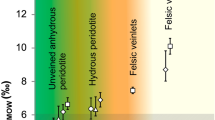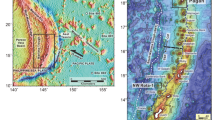Abstract
The nature of metasomatizing fluids and melts in the mantle are of interest for understanding the chemical evolution of the Earth's interior1,2,3. The study of noble-gas isotopes in appropriate mantle-derived samples has the potential to provide valuable insight into this question, by constraining the origin of the fluids and the timing of metasomatic events. Here we report the application of neon-isotope systematics to investigate the metasomatic history of apatite grains in spinel-lherzolite xenoliths from the Australian lithospheric mantle. We find that the apatite has a neon-isotope signature similar to that associated with plume-related volcanism, as is found in Hawaii, whereas coexisting mineral phases (olivine and amphibole) and non-apatite-bearing lherzolites have isotope signatures more typical of mid-ocean-ridge basalts. The occurrence of plume-like neon in the apatite implicates deep plume-like material beneath southeastern Australia as the source of the metasomatizing agent.
This is a preview of subscription content, access via your institution
Access options
Subscribe to this journal
Receive 51 print issues and online access
$199.00 per year
only $3.90 per issue
Buy this article
- Purchase on Springer Link
- Instant access to full article PDF
Prices may be subject to local taxes which are calculated during checkout

Similar content being viewed by others
References
McDonough, W. F. & McCulloch, M. T. The southeast Australian lithospheric mantle: isotopic and geochemical constraints on its growth and evolution. Earth Planet. Sci. Lett. 86, 327–340 (1987).
Meen, K. J., Eggler, D. H. & Ayers, J. C. Experimental evidence for very low solubility of rare-earth elements in CO2-rich fluids at mantle conditions. Nature 340, 301–303 (1989).
O'Reilly, S. Y. & Griffin, W. L. Mantle-metasomatism beneath western Victoria, Australia: I. Metasomatic processes in Cr-diopside lherzolites. Geochim. Cosmochim. Acta 52, 433–447 (1988).
Griffin, W. L., Wass, S. Y. & Hollis, J. D. Ultramafic xenoliths from Bullenmerri and Gnotuk maars, Victoria, Australia: Petrology of sub-continental crust-mantle transition. J. Petrol. 25, 53–87 (1984).
Sarda, P., Staudacher, T. & Allègre, C. J. Neon isotopes in submarine basalts. Earth Planet. Sci. Lett. 91, 73–88 (1988).
Craig, H. & Lupton, J. E. in The Sea (ed. Emiliani, C.) 391–428 (Wiley, New York, (1981)).
Porcelli, D., O'Nions, R. K. & O'Reilly, S. Y. Helium and strontium isotopes in ultramafic xenoliths. Chem. Geol. 54, 237–249 (1986).
O'Reilly, S. Y., Griffin, W. L. & Ryan, C. G. Residence of trace elements in metasomatized spinel lherzolite xenoliths: a proton-microprobe study. Contrib. Mineral. Petrol. 109, 93–113 (1991).
Benkert, J.-P., Baur, H., Signer, P. & Wieler, R. He, Ne, and Ar from the solar wind and solar energetic particles in lunar ilmenites and pyroxenes. J. Geophys. Res. 98, 13147–13162 (1993).
Honda, M., McDougall, I., Patterson, D. B., Doulgeris, A. & Clague, D. A. Possible solar noble gas component in Hawaiian basalts. Nature 349, 149–151 (1991).
Honda, M., McDougall, I., Patterson, D. B., Doulgeris, A. & Clague, D. A. Noble gases in submarine pillow basalt glasses from Loihi and Kilauea, Hawaii: a solar component in the Earth. Geochim. Cosmochim. Acta 57, 859–874 (1993).
Hiyagon, H., Ozima, M., Marty, B., Zashu, S. & Sakai, H. Noble gases in submarine glasses from mid-oceanic ridges and Loihi seamount: constraint on the early history of the Earth. Geochim. Cosmochim. Acta. 56, 1301–1316 (1992).
Staudacher, R., Sarda, P. & Allègre, C. J. Noble gas systematics of Réunion Island, Indian Ocean. Chem. Geol. 89, 1–17 (1990).
Valbracht, P. J. et al. Helium, neon and argon isotope systematics in Kerguelen ultramafic xenoliths: implication for mantle source signatures. Earth Planet. Sci. Lett. 138, 29–38 (1996).
Poreda, R. J. & Farley, K. A. Rare gases in Samoan xenoliths. Earth Planet. Sci. Lett. 113, 129–144 (1992).
Kennedy, B. M., Lynch, M. A., Reynolds, J. H. & Smith, S. P. Intensive sampling of noble gases in fluids at Yellowstone: I. Early overview of the data; regional pattern. Geochim. Cosmochim. Acta 49, 1251–1261 (1985).
Wellman, P. & McDougall, I. Cainozoic igneous activity in eastern Australia. Tectonophysics 23, 49–45 (1974).
McDonough, W. F., McCulloch, M. T. & Sun, S. S. Isotopic and geochemical systematics in Tertiary-Recent basalts from southeastern Australia and implications for the evolution of the sub-continental lithosphere. Geochim. Cosmochim. Acta 49, 2051–2067 (1985).
O'Reilly, S. Y. & Zhang, M. Geochemical characteristics of lava-field basalts from eastern Australia and inferred sources: connections with the subcontinental lithospheric mantle? Contrib. Mineral. Petrol. 121, 148–170 (1995).
Cull, J. P. An appraisal of Australian heatflow data. Bur. Miner. Resour. J. Austr. Geol. Geophys. 7, 11–21 (1982).
Cull, J. P. & Conley, D. Geothermal gradients and heat flow in Australian Sedimentary basins. Bur. Miner. Resour. J. Austr. Geol. Geophys. 8, 329–337 (1983).
Zielhuis, A. & Hilst, R. D. v. d. Upper mantle shear velocity beneath eastern Australia from inversion of waveforms from SKIPPY portable arrays. Geophys. J. Int. 127, 1–16 (1996).
Wass, S. Y. in The Mantle Sample: Inclusions in Kimberlites and Other Volcanics (Proc. 2nd Int. Kimberlite Conf., 2) (eds Boyd, F. R. & Meyer, H. O. A.) 366–373 (Am. Geophys. Un., Washington, (1979)).
Anderson, T., O'Reilly, S. Y. & Griffin, W. L. The trapped fluid phase from Victoria, Australia: implications for mantle metasomatism. Contrib. Mineral. Petrol. 88, 72–85 (1984).
O'Reilly, S. Y. in Mantle Xenoliths (ed. Nixon, P. H.) 661–6 (Wiley, Chichester, (1987)).
Yaxley, G. M., Crawford, A. J. & Green, D. H. Evidence for carbonatite metasomatism in spinel peridotite xenoliths from western Victoria, Australia. Earth Planet. Sci. Lett. 107, 305–317 (1991).
Griffin, W. L., O'Reilly, S. Y. & Stabel, A. Mantle metasomatism beneath western Victoria, Australia: II. Isotopic geochemistry of Cr-diopside lherzolites and Al-augite pyroxenites. Geochim. Cosmochim. Acta 52, 449–459 (1988).
Wetherill, G. W. Variations in the isotopic abundances of neon and argon extracted from radioactive minerals. Phys. Rev. 96, 679–683 (1954).
Hünemohr, H. Edelgase in U- und Th-reichen Mineralen und die Bestimmung der 21Ne-Dicktarget-Ausbeute der 18O(α,n)21Ne-kernreaction im Bereich 4.0–8.8 MeV. Thesis, Johannes-Gutenberg-Universität (1989).
Yatsevich, I. & Honda, M. Production of nucleogenic neon in the Earth from natural radioactive decay. J. Geophys. Res. 102, 10291–10298 (1997).
Barton, C. E. & McElhinny, M. W. A10000 yr geomagnetic secular variation record from three Australian maars. Geophys. J. R. Astron. Soc. 67, 465–485 (1981).
Acknowledgements
We thank W. Griffin for advising on appropriate samples for this study, and for comments on the manuscript; J. M. McCarron for providing the Mr Gambier samples; and G. Yaxley and M. Handler for comments.
Author information
Authors and Affiliations
Corresponding author
Rights and permissions
About this article
Cite this article
Matsumoto, T., Honda, M., McDougall, I. et al. Plume-like neon in a metasomatic apatite from the Australian lithospheric mantle. Nature 388, 162–164 (1997). https://doi.org/10.1038/40606
Received:
Accepted:
Issue Date:
DOI: https://doi.org/10.1038/40606
This article is cited by
-
Magnetotelluric support for edge-driven convection and shear-driven upwelling in the Newer Volcanics Province
Scientific Reports (2023)
-
Noble gases confirm plume-related mantle degassing beneath Southern Africa
Nature Communications (2019)
-
The high PT stability of apatite and Cl partitioning between apatite and hydrous potassic phases in peridotite: an experimental study to 19 GPa with implications for the transport of P, Cl and K in the upper mantle
Contributions to Mineralogy and Petrology (2012)
-
Preliminary study on noble gas isotopes of mantle-derived peridotite xenoliths along the Tan-Lu Fault belt, Eastern China
Geosciences Journal (2004)
-
Helium isotope studies of the mantle xenoliths and megacrysts from the Cenozoic basalts in the eastern China
Science in China Series D: Earth Sciences (2002)
Comments
By submitting a comment you agree to abide by our Terms and Community Guidelines. If you find something abusive or that does not comply with our terms or guidelines please flag it as inappropriate.



